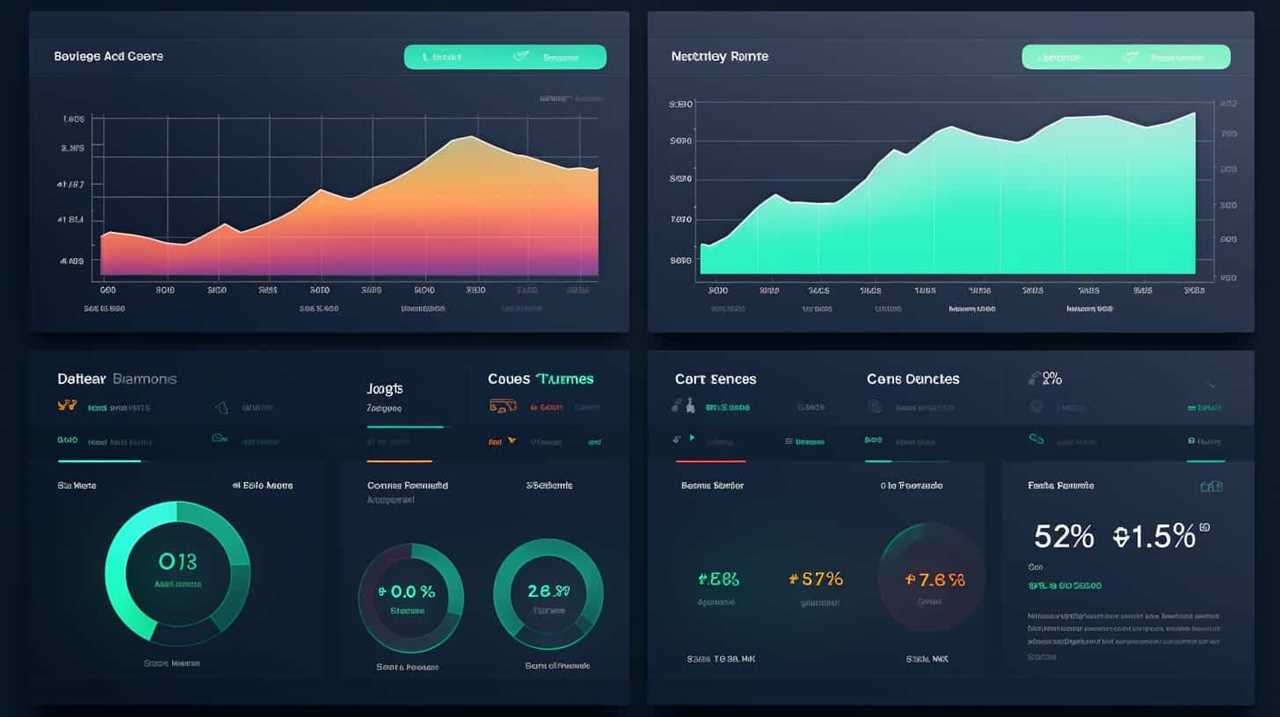- Keyword placement: How to strategically place keywords in title tags and meta descriptions for maximum impact.
- Writing compelling copy: Tips for crafting enticing title tags and meta descriptions that attract both search engines and users
Searching for ways to improve your SEO capabilities? Look no further – this comprehensive guide is designed specifically for you.
In this article, we’ll share the 10 best strategies for implementing holistic SEO that will skyrocket your website’s visibility and rankings.
From keyword research to continuous monitoring and optimization, we’ve got you covered.
So grab a cup of coffee, sit back, and get ready to master the art of holistic SEO.

Let’s dive in!
Key Takeaways
- Prioritize identifying high-volume keywords relevant to the target audience.
- Optimize keyword placement in website content for maximum impact.
- Conduct keyword research to identify relevant keywords for content optimization.
- Implement responsive web design for optimal user experience on mobile devices.
Keyword Research
When conducting keyword research for holistic SEO implementation, we should prioritize identifying high-volume keywords that are relevant to our target audience.
One effective strategy is to perform competitor analysis to gain insights into the keywords that our competitors are targeting. By understanding what keywords they’re ranking for, we can identify opportunities to optimize our own content and gain a competitive edge.
Additionally, it’s essential to consider long tail keywords, which are longer and more specific phrases that have lower search volume but higher conversion rates. These keywords allow us to target a specific audience and capture highly qualified leads.

On-Page Optimization
When it comes to on-page optimization, there are two key points to consider: the importance of meta tags and content optimization tips.
Meta tags play a crucial role in helping search engines understand the content of a webpage, so it’s essential to optimize them with relevant keywords and accurate descriptions.
Content optimization involves creating high-quality, informative, and engaging content that’s optimized for both users and search engines.
Meta Tags Importance
Implementing holistic SEO requires understanding the importance of meta tags for on-page optimization. Meta tags provide information to search engines about the content of your web page, helping them to understand what your page is about and how it should be ranked.

Here are some best practices for meta tag optimization:
- Meta Descriptions: Writing compelling and relevant meta descriptions can increase the click-through rate of your website in search engine results. It’s important to include relevant keywords and a clear call-to-action to entice users to click on your link.
- Title Tags: Your title tags should accurately describe the content of your page and include relevant keywords. It’s recommended to keep your title tags between 50-60 characters to ensure they’re fully displayed in search results.
- Meta Keywords: While meta keywords aren’t as important as they used to be, it’s still worth including relevant keywords that describe the content of your page. However, avoid keyword stuffing as it can have a negative impact on your SEO.
Content Optimization Tips
Continuing the discussion on on-page optimization, let’s explore some effective content optimization tips for holistic SEO.
When it comes to content promotion, it’s crucial to create high-quality, valuable content that meets the needs of your target audience.
Start by conducting keyword research to identify relevant keywords and incorporate them naturally throughout your content.

Utilize SEO tools like Google Analytics and SEMrush to track the performance of your content and make data-driven decisions.
Additionally, optimize your title tags, meta descriptions, and headings to improve your website’s visibility in search engine results.
Don’t forget to optimize your images by using alt tags and compressing their file sizes for faster loading times.
Technical SEO
One important aspect of achieving holistic SEO is by effectively incorporating technical SEO strategies. Technical SEO focuses on optimizing the technical aspects of a website to improve its search engine visibility and user experience.

To implement technical SEO effectively, consider the following strategies:
- Conduct an SEO audit and analysis: Start by evaluating your website’s current technical performance and identifying areas that need improvement. This includes analyzing site speed, mobile-friendliness, URL structure, and crawlability.
- Optimize website speed: Website speed is crucial for both search engine rankings and user experience. Minimize file sizes, leverage browser caching, and optimize code to improve loading times.
- Ensure mobile-friendliness: With the majority of internet users accessing websites through mobile devices, it’s essential to have a responsive design that adapts to different screen sizes. Test your website on various devices to ensure a seamless mobile experience.
Content Creation and Optimization
When it comes to content creation and optimization for SEO, we need to focus on quality over quantity. While it’s important to have a sufficient amount of content to rank well in search engines, it’s even more crucial to ensure that the content is valuable, relevant, and engaging to users.
Additionally, keyword research techniques play a vital role in optimizing content for SEO. By identifying the right keywords and incorporating them strategically throughout the content, we can increase the visibility and relevance of our website in search results.
Quality Vs Quantity
To effectively implement holistic SEO, we prioritize quality over quantity in content creation and optimization. While it may be tempting to churn out a large quantity of content to improve search engine rankings, focusing on quality is key to long-term success. Here’s why:

- User Engagement: High-quality content is more likely to engage users, keeping them on your site longer and reducing bounce rates. This signals to search engines that your website is valuable and deserving of a higher ranking.
- Reputation Building: Quality content helps establish your brand as a trusted authority in your industry. This can lead to increased brand awareness, credibility, and ultimately, more organic traffic.
- Link Building: Valuable, well-researched content is more likely to attract high-quality backlinks from other reputable websites. These backlinks are crucial for improving your website’s domain authority and search engine rankings.
Keyword Research Techniques
Now that we’ve prioritized quality over quantity in content creation and optimization, let’s delve into the effective keyword research techniques for holistic SEO.
One of the first steps in keyword research is conducting competitor analysis. By analyzing the keywords your competitors are targeting, you can gain valuable insights and identify opportunities for your own content.
Additionally, focusing on long tail keywords can help you target specific and niche audiences, resulting in higher conversion rates. Long tail keywords are longer and more specific phrases that have lower competition but higher intent. By incorporating these keywords into your content, you can attract highly motivated visitors who are more likely to engage with your website.
With a solid understanding of competitor analysis and long tail keywords, you can optimize your content to reach the right audience and improve your search engine rankings.

Now, let’s move on to the next section, where we’ll explore the importance of user experience and website design in holistic SEO.
User Experience and Website Design
Our research has revealed that implementing user-friendly website design is a crucial aspect of holistic SEO strategy. The user experience and website design play a significant role in user engagement and overall website performance.
Here are three key factors to consider when optimizing user experience and website design:
- Visual Appeal: A visually appealing website design captures users’ attention and encourages them to stay longer on your site. Using high-quality images, clear typography, and a clean layout can enhance the visual appeal of your website.
- Easy Navigation: A well-structured and intuitive navigation system allows users to find the information they need quickly and easily. Implementing clear menus, breadcrumbs, and search functionality can help improve user experience and reduce bounce rates.
- Mobile Responsiveness: With the increasing use of mobile devices, it’s crucial to ensure that your website is mobile-friendly. Responsive design allows your website to adapt to different screen sizes, providing a seamless experience for users on any device.
Mobile-Friendliness
When it comes to implementing holistic SEO, one crucial aspect to consider is mobile-friendliness.

With the rise of mobile devices, it’s essential to ensure that your website is optimized for mobile users. This can be achieved through responsive web design and mobile site optimization.
Responsive Web Design
To achieve optimal results in holistic SEO, we prioritize implementing responsive web design for mobile-friendliness. With the increasing use of smartphones and tablets, it’s crucial to ensure that your website is accessible and user-friendly across different devices.
Here are three reasons why responsive web design is essential for mobile-friendliness:
- Improved User Experience: Responsive design ensures that your website adapts to different screen sizes, providing a seamless browsing experience for mobile users. This leads to increased engagement, lower bounce rates, and higher conversion rates.
- Better SEO Performance: Google prioritizes mobile-friendly websites in search engine rankings. By implementing responsive design, you enhance your chances of ranking higher and driving organic traffic to your site.
- Cost and Time Efficiency: Responsive design eliminates the need for separate mobile app development, saving you time and resources. It also simplifies website speed optimization, as there’s only one version of your site to optimize.
Mobile Site Optimization
Implementing mobile site optimization is crucial for holistic SEO because it ensures that your website is mobile-friendly and accessible to a wider audience. In today’s digital landscape, more and more people are using their smartphones and tablets to browse the internet. Therefore, it’s essential that your website is optimized for mobile devices to provide a seamless user experience.

Two important aspects of mobile site optimization are mobile site speed and mobile site navigation. Mobile site speed refers to how quickly your website loads on mobile devices. A slow-loading website can frustrate users and lead to high bounce rates. On the other hand, a fast-loading website can improve user experience and increase the likelihood of conversions.
Mobile site navigation refers to how easily users can navigate your website on mobile devices. It’s important to prioritize simplicity and ease of use, ensuring that visitors can find the information they’re looking for quickly and effortlessly.
By optimizing your website for mobile devices, you can reach a larger audience and improve your website’s visibility in search engine rankings. This will ultimately lead to increased traffic and better overall SEO performance.
Now that we’ve discussed the importance of mobile site optimization, let’s move on to the next section: link building and outreach.

Link Building and Outreach
Effective link building and outreach are essential components of a holistic SEO strategy. By strategically building links and reaching out to relevant sources, you can improve your website’s visibility and authority, ultimately boosting its search engine rankings. Here are three key strategies to consider:
- Develop high-quality content:
Creating valuable and shareable content is crucial for attracting natural backlinks. Focus on producing informative articles, engaging videos, and helpful resources that other websites would want to link to. - Guest blogging:
Writing guest posts for reputable websites in your industry is an effective way to build quality backlinks. It allows you to showcase your expertise and reach a wider audience while earning valuable links back to your site. - Influencer outreach:
Collaborating with influencers and industry experts can help you gain exposure and build authoritative links. Reach out to relevant influencers, offer valuable content or partnerships, and leverage their networks to amplify your brand’s reach.
By implementing these link building strategies and outreach techniques, you can enhance your website’s visibility and credibility.
Now, let’s delve into the next section about social media integration.
SUBSEQUENT SECTION: ‘Social Media Integration’
Social Media Integration
Our approach to social media integration revolves around utilizing its potential to enhance our holistic SEO strategy. Social media engagement plays a crucial role in driving organic traffic and improving search engine rankings. By incorporating social media marketing strategies into our SEO efforts, we can amplify our brand’s reach and visibility.

Through regular content sharing, community building, and active engagement with our audience, we can create a strong online presence that not only attracts more visitors but also encourages them to interact and share our content. This increased engagement signals to search engines that our website is valuable and relevant, ultimately boosting our SEO performance.
Analytics and Reporting
To accurately measure the impact of our social media integration efforts, we rely on analytics and reporting to provide us with valuable data and insights. Data analysis plays a crucial role in understanding the performance of our SEO strategies and optimizing them for better results.
Here are three key reasons why analytics and reporting are essential for effective SEO implementation:
- Tracking Performance: Analytics allows us to monitor the performance of our website and individual pages, providing us with valuable information on user behavior, traffic sources, and conversion rates. By analyzing this data, we can identify areas of improvement and make data-driven decisions to enhance our SEO efforts.
- Identifying Trends: Through data analysis, we can uncover trends and patterns in user behavior, keyword rankings, and content performance. This helps us identify opportunities for optimization and adjust our SEO strategies accordingly.
- Measuring ROI: Analytics and reporting enable us to measure the return on investment (ROI) of our SEO initiatives. By tracking key metrics such as organic traffic, leads generated, and revenue generated, we can determine the effectiveness of our SEO efforts and justify our investment in holistic SEO.
Continuous Monitoring and Optimization
By implementing continuous monitoring and optimization, we can ensure that our SEO strategies remain dynamic and responsive to the ever-changing digital landscape.

Continuous improvement is vital in the world of SEO, as algorithms and trends are constantly evolving. Through regular monitoring of our website’s performance, we can identify areas of improvement and make necessary adjustments to enhance our online visibility and rankings.
A/B testing is another powerful tool we can utilize to optimize our SEO efforts. By testing different versions of our website, content, or marketing campaigns, we can gather valuable data and insights to determine which strategies are most effective in driving traffic and conversions.
This data-driven approach allows us to make informed decisions and refine our SEO strategies for maximum impact.
With continuous monitoring and optimization, we can stay ahead of the game and achieve long-term success in the competitive world of SEO.

Frequently Asked Questions
How Can I Determine the Right Keywords to Target for My Website?
To determine the right keywords for your website, we use keyword research tools and employ SEO keyword optimization. By analyzing search volume, competition, and relevance, we identify the most effective keywords to target for optimal website performance.
What Are Some Best Practices for Optimizing On-Page Elements Like Title Tags and Meta Descriptions?
Optimizing on-page elements like title tags and meta descriptions is crucial for improving SEO. We’ll discuss how to strategically place keywords and craft enticing copy that attracts both search engines and users.
How Can I Improve the Technical Aspects of My Website, Such as Site Speed and Crawlability?
To improve website performance and enhance accessibility, we focus on optimizing site speed and crawlability. By implementing techniques such as optimizing images, minifying code, and improving server response time, we can ensure a smooth and efficient user experience.
What Are Some Strategies for Creating Quality Content That Both Search Engines and Users Will Love?
Creating engaging content that incorporates multimedia is crucial for both search engines and users. By focusing on high-quality, informative content, we can optimize our website for better visibility and user experience.

How Can I Ensure That My Website Offers a Great User Experience and Is Visually Appealing in Terms of Design?
To ensure a visually appealing website design and great user experience, we focus on creating a seamless interface with intuitive navigation, engaging visuals, and responsive layouts that adapt to different devices.
Conclusion
Implementing holistic SEO is like nurturing a thriving garden.
By carefully choosing the right keywords, optimizing on-page elements, and ensuring technical excellence, we lay the foundation for success.
Creating quality content, designing user-friendly websites, and building strong connections through link building and social media integration are the seeds that grow into fruitful results.

With continuous monitoring and optimization, we cultivate a flourishing online presence that delights both search engines and users alike.
Together, we can transform your website into a vibrant digital sanctuary.










